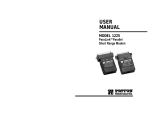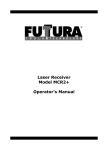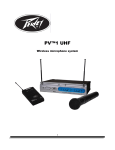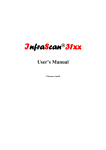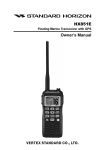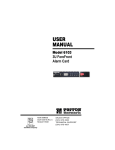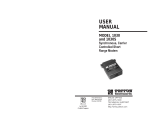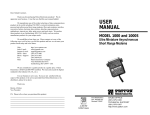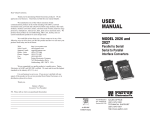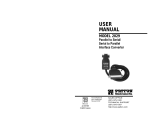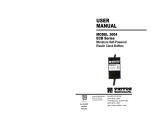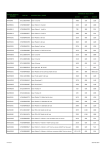Download Model 1225
Transcript
USER MANUAL MODEL 1225 ParaLinkTM Parallel Short Range Modem Part #07M1225-B Doc. #104011UB Revised 9/12/97 CERTIFIED An ISO-9001 Certified Company SALES OFFICE (301) 975-1000 TECHNICAL SUPPORT (301) 975-1007 http://www.patton.com 1.0 WARRANTY INFORMATION 1.3 SERVICE Patton Electronics warrants all Model 1225 components to be free from defects, and will—at our option—repair or replace the product should it fail within one year from the first date of shipment. This warranty is limited to defects in workmanship or materials, and does not cover customer damage, abuse or unauthorized modification. If this product fails or does not perform as warranted, your sole recourse shall be repair or replacement as described above. Under no condition shall Patton Electronics be liable for any damages incurred by the use of this product. These damages include, but are not limited to, the following: lost profits, lost savings and incidental or consequential damages arising from the use of or inability to use this product. Patton Electronics specifically disclaims all other warranties, expressed or implied, and the installation or use of this product shall be deemed an acceptance of these terms by the user. All warranty and non-warranty repairs must be returned freight prepaid and insured to Patton Electronics. All returns must have a Return Materials Authorization number on the outside of the shipping container. This number may be obtained from Patton Electronics Technical Service at (301) 975-1007; http://www.patton.com: or, [email protected]. NOTE: Packages received without an RMA number will not be accepted. Patton Electronics' technical staff is also available to answer any questions that might arise concerning the installation or use of your Model 1225. Technical Service hours: 8AM to 5PM EST, Monday through Friday. 1.1 RADIO AND TV INTERFERENCE The Model 1225 generates and uses radio frequency energy, and if not installed and used properly—that is, in strict accordance with the manufacturer's instructions—may cause interference to radio and television reception. The Model 1225 is designed to provide reasonable protection from such interference in a commercial installation. However, there is no guarantee that interference will not occur in a particular installation. If the Model 1225 does cause interference to radio or television reception, which can be determined by disconnecting the Model 1225 from both parallel interfaces, the user is encouraged to try to correct the interference by one or more of the following measures: moving the computing equipment away from the receiver, re-orienting the receiving antenna and/or plugging the receiving equipment into a different AC outlet (such that the computing equipment and receiver are on different branches). 1.2 CE NOTICE The CE symbol on your Patton Electronics equipment indicates that it is in compliance with the Electromagnetic Compatibility (EMC) directive and the Low Voltage Directive (LVD) of the Union European (EU). A Certificate of Compliance is available by contacting Patton Technical Support. 1 2 2.0 GENERAL INFORMATION 3.0 CONFIGURATION Thank you for your purchase of this Patton Electronics product. This product has been thoroughly inspected and tested and is warranted for One Year parts and labor. If any questions or problems arise during installation or use of this product, please do not hesitate to contact Patton Electronics Technical Support at (301) 975-1007. The Model 1225 is designed to be easy to use. There are no internal jumpers or DIP switches to set, so there is no need to open the case to configure the unit (you may need to open the case for wire connection—refer to Section 4.0). 2.1 FEATURES • • • • • • • • • The only configuration necessary for operation is proper setting of the external BUSY / ACKNOWLEDGE switch. The diagram below shows the location of the BUSY / ACKNOWLEDGE switch on the PC board, as well as the location of the terminal block. Extends parallel communication to 2000 feet Requires no AC power or batteries Operates over a single twisted pair Allows devices to communicate in “real time” Can be configured for BUSY or ACKNOWLEDGE flow control methods Compatible with most printer sharing devices Transmits DC power over the line to compensate for low power parallel printer interfaces DB-25 or Centronics parallel connections RJ-11, RJ-45 or terminal block line connections Busy Ack BUSY/ ACKNOWLEDGE Switch G S Terminal Block 2.2 DESCRIPTION The Patton Electronics Model 1225 ParaLinkTM parallel short range modem allows a PC and a parallel output device (printer, sharing switch, etc.) to communicate at distances to 2000 feet over a single unconditioned twisted pair. Supporting parallel data rates to 5 Kbytes per second (serial rates to 40 Kbps), the Model 1225 derives all necessary operating power from the parallel interface—no AC power or batteries are required. The Model 1225 always works in pairs: A transmitter unit is plugged into the PC parallel port and a receiver unit is plugged into the output device parallel port. The connection between them is serial, and functions at speeds high enough to allow “real time” parallel communication between the two parallel devices. The Model 1225 has two unique features that allow it to operate in a wide variety of parallel applications: First, the Model 1225 transmitter is able to send DC power down the line to the receiver in order to compensate for low power parallel printer interfaces. Second, the Model 1225 can be configured for either BUSY or ACKNOWLEDGE flow control methods. The Model 1225 receiver is available with either a DB-25 or Centronics parallel interface (transmitter has DB-25 only). Line connection options are RJ-11, RJ-45 or terminal block with strain relief. 3 3.1 SETTING THE BUSY / ACKNOWLEDGE SWITCH For your convenience, the Model 1225 has an externally accessible BUSY / ACKNOWLEDGE switch (see diagram below). Set the switch on both transmitter and receiver as follows: Busy Ack 1. The switch must be set the same way on both transmitter and receiver. 2. Set the switch to ACKNOWLEDGE on both the transmitter and reeiver. This should achieve good results in most applications. 3. If you experience loss of information or other problems with both switches set to ACKNOWLEDGE, set both switches to BUSY. 4 4.0 INSTALLATION Once you have configured the Model 1225 transmitter and receiver, you must connect the system. This section will tell you how to connect the transmitter and receiver via twisted pair wire and how to connect the two devices to your system hardware. 2. Strip the outer insulation from the twisted pairs about one inch from the end. 4.1 CONNECTING THE LINE SIDE 3. Strip back the insulation on each of the 2 wires about .25”. Depending upon the type of units you have ordered, you can connect twisted pair wire to the Model 1225 using internal terminal blocks (with strain relief) or modular jacks. The following pages describe both kinds of twisted pair connection. 4.1.1 TERMINAL BLOCK CONNECTION Terminal blocks are used to connect a single pair of bare wires to the Model 1225. The following instructions will tell you how to open the case, connect the bare wires and fasten the strain relief collar in place. 4. Insert the two-wire data line to the center (signal) and shield (ground) terminal posts, then tighten the screws. 1. Open the unit by gently inserting a screwdriver between the DB-25 connector and the lip of the plastic case (see below). You don't have to worry about breaking the plastic, but be careful not to bend the D-sub connector. G S NOTE: Make sure the twisted pair cable between the transmitter and receiver is wired straight through as shown below: After you have opened the unit's case, you will find the terminal block mounted at the rear of the PC board. The terminals are labeled “S” for “signal” and “G” for “ground”. 5 SIGNAL (S)--------------------- (S) SIGNAL GROUND (G)--------------------- (G) GROUND 6 4. Place the 2 halves of the strain relief assembly on either side of the telephone wire and press together very lightly. Slide the assembly so that it is about 2 inches from the terminal posts and press together firmly. G S 5. Insert the strain relief assembly and the wire into the slot in the bottom half of the modem case. Set it into the recess in the case. (If the telephone wire does not fit into the strain relief assembly, call Patton Electronics Technical Support at 301-975-1007. We have strain relief collars to suit a variety of cable diameters.) 6. BEND the top half of the case as necessary to place it over the strain relief assembly. Do not snap the case together yet. 7. Insert one captive screw through a saddle washer and then insert the entire piece through the hole in the DB-25 end of the case. Snap that side of the case closed. Repeat the process for the other side. This completes the installation process. 4.1.2 RJ-11 & RJ-45 LINE CONNECTION When using the RJ-11 or RJ-45 modular jacks, install “straight through” cabling between the transmitter and receiver as shown below: RJ-11 JACKS SIGNAL PIN# COLOR DATA GND 3 4 COLOR Green† --------------Green Red------------------Red PIN# SIGNAL 3 4 DATA GND PIN# SIGNAL 4 5 DATA GND RJ-45 JACKS G S SIGNAL PIN# COLOR DATA GND 4 5 COLOR Red† -----------------Red Green ---------------Green 1 - Blue 2 - Orange 3 - Black 4 - Red 5 - Green 6 - Yellow 7 - Brown 8 - Slate 1 - Blue 2 - Yellow 3 - Green 4 - Red 5 - Black 6 - White † 7 Standard AT&T color codes—yours may be different 8 APPENDIX A 4.2 CONNECTING TO PARALLEL HARDWARE PATTON MODEL 1225 SPECIFICATIONS After connecting the twisted pair line to the Model 1225 transmitter and receiver, you are ready to connect the units to your parallel hardware. The following steps explain this process: 1. 2. Plug the DB-25 male connector on the Model 1225 transmitter directly into the parallel port of the sending device (which is normally a PC, terminal, host or similar DTE). Note: If you cannot plug the transmitter directly into the parallel port, use a straight through DB-25 parallel cable of the shortest possible length. We recommend 6 feet or less. The Model 1225 receiver is available with either a DB-25 (male or female) or 36-pin Centronics (male only) connector. The DB-25 version is designed for direct connection to various print servers and switches. The Centronics version is designed for direct connection to the Centronics port of a parallel printer. Note: If you cannot plug the receiver directly into the port, use a straight through cable of the shortest possible length. We recommend 6 feet or less. 4.3 OPERATING THE MODEL 1225 Parallel Interface: Transmitter, DB-25 male; Receiver, DB-25 male or female, 36-pin Centronics male Power: Interface powered, no AC power or batteries needed Range: 2,000 feet Transmission: Half duplex over a single shielded or unshielded twisted pair (19 - 26 AWG) Line Interface: RJ-11, RJ-45 or terminal block with strain relief Data Rate: 5 Kbytes per second on parallel interface (40 Kbps on serial line) Interface Signals: Data bits 0-7, ground, Busy or Acknowledge (externally switch selectable) Dimensions: 2.67” x 2.10” x 0.74” Once the transmitter and receiver have been connected to each other and to their corresponding parallel input and output devices, you are ready to operate the units. Make sure that the BUSY/ACK switch on both units are placed on the same setting. Otherwise, the units should function transparently, just like a cable. There is no ON / OFF switch. If your Model 1225’s are not operating properly, double-check all of your connections and try again. If you still experience problems, change the BUSY / ACKNOWLEDGE setting on both units and try again. If you still do not obtain satisfactory results, call Patton Technical Support at (301) 975-1007. 9 10 APPENDIX B APPENDIX C PATTON MODEL 1225 BLOCK DIAGRAM (Transmitter) PATTON MODEL 1225 PARALLEL PIN CONFIGURATIONS SOURCE Common Common Common Common Common Common Common Common Printer TRANSMITTER / RECEIVER (DB-25) Error (Fault - Active LOW) DIRECTION Printer 13- Select (Active HIGH) 12- Paper End (Active HIGH) 11- Busy (Active HIGH) 10- Acknowledge (Active LOW) 9- Data Bit 8 (MSB) 8- Data Bit 7 7- Data Bit 6 6- Data Bit 5 5- Data Bit 4 4- Data Bit 3 3- Data Bit 2 2- Data Bit 1 (LSB) 1- Data Strobe (Active LOW) Return / Ground -25 Return / Ground -24 Return / Ground -23 Return / Ground -22 Return / Ground -21 Return / Ground -20 Return / Ground -19 Return / Ground -18 RECEIVER (CENTRONICS) -36 -35 -34 -33 Fault (Active Low) -32 -31 -30 -29 -28 -27 -26 -25 -24 -23 -22 -21 -20 -19 18- (+) 5 Volts 17- Chassis Ground 16- Logic Ground 151413- Select (Active HIGH) 12- Paper End (Active HIGH) 11- Busy (Active HIGH) 10- Acknowledge (Active High) 9- Data Bit 8 (MSB) 8- Data Bit 7 7- Data Bit 6 6- Data Bit 5 5- Data Bit 4 4- Data Bit 3 3- Data Bit 2 2- Data Bit 1 (LSB) 1- Data Strobe (Active LOW) 11 SOURCE Printer Printer Printer Printer Computer Computer Computer Computer Computer Computer Computer Computer Computer DIRECTION Printer Common Common Printer Printer Printer Printer Computer Computer Computer Computer Computer Computer Computer Computer Computer 12 APPENDIX C (continued) PATTON MODEL 1225 BLOCK DIAGRAM (Centronics Receiver) APPENDIX C (continued) PATTON MODEL 1225 BLOCK DIAGRAM (DB25 Receiver) Copyright © 1997 Patton Electronics Company All Rights Reserved 13 14








